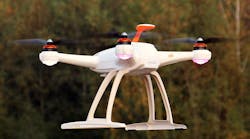Trends come and go. In some cases, a trend may last a couple of months, usually it only lasts about a week. Then there are trends that may eventually become the norm.
The construction industry and the decision-makers involved in the purchasing of new trucks and equipment view recent investments made in new trucks and equipment as anything but a short-term trend.
According to the ROADS & BRIDGES’ Equipment Ownership Survey 2000 (EOS 2000), an increasing number of new trucks and equipment are being purchased by contractors, county agencies, municipalities/townships and state DOTs.
Based upon figures from 1999, the planned purchases for 2000 and the projected purchases for 2001, the survey revealed no sign of a truck and construction equipment market recession any time soon.
The strong numbers in favor of truck and equipment purchase decisions are due to the passage of TEA-21, whose funds finally seem to be making their way to state DOTs, in addition to a consistently strong economy.
"I think that you will see more new purchases this year because of TEA-21," said Jim Kenny, vice president of Kenny Construction. "In the next five years you will see it continuing because of the new highway work."
This is encouraging news for both the truck and equipment manufacturers, as well as the users.
The EOS 2000 received a total of 578 responses out of 4,000 surveys sent out. Representative of the magazine’s circulation list, the surveys were mailed to contractors, municipalities, county agencies and state DOTS in order to estimate their equipment purchasing for the next two years.
Recipients of the survey were selected on a random basis, all of whom indicated they are responsible for buying or specifying truck trailers and mobile equipment. With a total of 578 responses out of 4,000, the response rate was 14.5%.
All of the percentages and numbers listed in the EOS 2000 are based on these 578 responses.
The classification of the 578 responses are: contractors, 49%; county agencies, 21%; municipalities/townships, 19%; and state DOTs, 11%.
Listed below are some of the relevant facts and figures uncovered by the EOS 2000 in each category, as well as a comparison of 1999 and 2000.
1999 vs. 2000
In comparing statistics from last year’s survey, the 2000 survey reported a 13% increase in the $1-$100,000 range pertaining to the amount of money expected to be invested in new trucks for this year. As far as all of the remaining monetary categories, which range from $100,000 to greater than $1 million, the amount likely to be invested in trucks in 2000 was +4% from the 1999 statistics.
The 2000 survey also indicated that the largest estimated number of new trucks to be purchased are in Class’ 1 and 8, which is consistent with the 1999 survey. Statistics in the remaining truck classes also are on par with 1999.
More importantly, approximately 28% of the respondents experienced an increase in the amount of money spent on new trucks from 1999 to 2000, while 35% of the respondents expect an increase of funds for 2001.
The positive results of the truck portion of the EOS 2000 have similar conclusions drawn by the CIT Groups’ 2000 Construction Industry Forecast.
CIT’s finding indicated that "highway trucks capture the No. 1 spot on the buyer’s wish list for equipment purchases in 2000. A spot they have occupied for four of the last five years."
Comments from Jordan Feiger, general manager, severe service business for the International Truck & Engine Co., mirror the findings of the EOS 2000 and the CIT Group as well.
"I believe it started back in 1992 in which every year has seen about a 6-7% annual increase in terms of truck sales," he said. "There have been cycles in there but if you stretch it out, say five years from now, we will continue to see the average annual increase. The overall demand from trucks is just going to continue to grow."
As far as new construction equipment is concerned, EOS 2000 reported an increase in the $100,000 - $300,000; $300,001 - $500,000; $500,001 - $750,000; $750,001 - $1 million; and greater than $1 million categories. The remaining two categories, no investment and $1 - $100,000, reported slight decreases in the number of respondents who defined these figures as investment possibilities in 2000.
After 23% of the respondents indicated an increase from 1999, 29% of the EOS 2000 respondents indicated an expected increase in the amount of money to be spent on new equipment in 2001.
Contractors
According to the survey, contractors aim to purchase motor graders, equipment trailers, tracked excavators, backhoes and wheel loaders. In comparison to the 1999 survey, the popularity of the equipment mentioned above remains strong, while interest in the other equipment categories such as sweepers and crawlers went unchanged.
"Basically what we [Kenny Construction] have been looking at are crawler cranes and hydraulic cranes as the major purchases for our bridge division," said Kenny. "Motor graders are another piece we look at as well."
Contractor statistics revealed that 23% expect to invest between $100,000 - $300,000 in new equipment in 2000, with 25% of the respondents reporting an increase in spending on new equipment in comparison to 1999. Additionally, 28% of the respondents expect to increase on their year 2000 spending in 2001.
When it comes to the amount of money being spent on new equipment, over 50% of the respondents plan to spend between $1 - $300,000 in 2000.
"In 2000, we will be spending in the area of a million dollars, which is an increase from previous years," said Kenny. "We will probably be spending more money on equipment next year, too."
Kenny said his company also is involved in leasing equipment for a project and purchasing that product after the project is done.
"Contractors are becoming more fiscally responsible with the money they’re putting into equipment," said Kenny. "There is a need to manage the cash flow better which has a lot to do with the rental market. But if you look at the age of some of the equipment that is out there, it is old."
County agencies
Motor graders and mowers came out on top when county agency respondents estimated what equipment they may purchase in 2000. Although, one piece of equipment also stood out, and that was concrete pavers.
Last year, 130 county agency respondents indicated that they planned to purchase only one concrete paver in 1999. With 120 responding this year, the answer was quite the contrast when 22 indicated that they might purchase concrete pavers.
Indicating an increase in the total amount of money spent on both new trucks and new equipment in 1999, the majority of county agency respondents plan to spend between $1 - $300,000 on new trucks and new equipment in 2000.
Based upon figures for the year 2000, approximately 37% of the county agencies expect an increase in spending for trucks in 2001, while 26% expect an increase in the amount of spending for new equipment in 2001.
Municipalities/townshipsWhat are the factors in determining a final purchase decision?
As far as municipalities/townships are concerned, brand preference, price, meeting specs, dealer service and the availability of parts, each rank highly among this group.
Their response revealed that backhoe loaders, mowers, wheel loaders and equipment trailers lead the way as the most popular equipment that may be purchased in 2000.
It also was revealed that Class 1 (<6,000 lb GVW) and Class 7 (26,001 lb - 33M GVW) are the most popular trucks which may be purchased in 2000 among this group.
"Municipalities are buying the trucks they always buy, every once in a while there may be some incremental buying because of some surplus and the opportunity to maybe buy some more, but it’s usually pretty consistent buying," said International’s Feiger.
Approximately 42% of the respondents said they expect to invest between $1 - $100,000 for new trucks in 2000, while 33% expect to invest in new construction equipment in 2000.
State DOTs
As was the case last year, state DOTs once again indicated that an increase in investments for new trucks and equipment is in the cards for 2001. Approximately 45% of the respondents expect an increase in the amount of money spent on trucks, while 56% expect an increase in the amount of money spent for new equipment. The survey revealed that both truck and equipment purchased by state DOTs is going to be in the $100,001 - $300,000 price range.
The New York DOT may be the exception.
"We spend about $10 million on Class 8 trucks every year," said Joe Darling, director of equipment management for the NYDOT. "Then there’s probably a couple of million dollars in pickups and light dump trucks."
Darling confirmed that these figures are consistent from last year. He also said that the NYDOT spends a couple of million dollars on construction equipment every year.
"Wheel loaders are our single largest purchase outside of trucks," said Darling.
Also consistent with last year’s survey, state DOTs confirmed that specifications and price are the two most important factors they consider when purchasing new equipment. Dealer service and manufacturer support, also in the same position last year, placed third and fourth, respectively.

